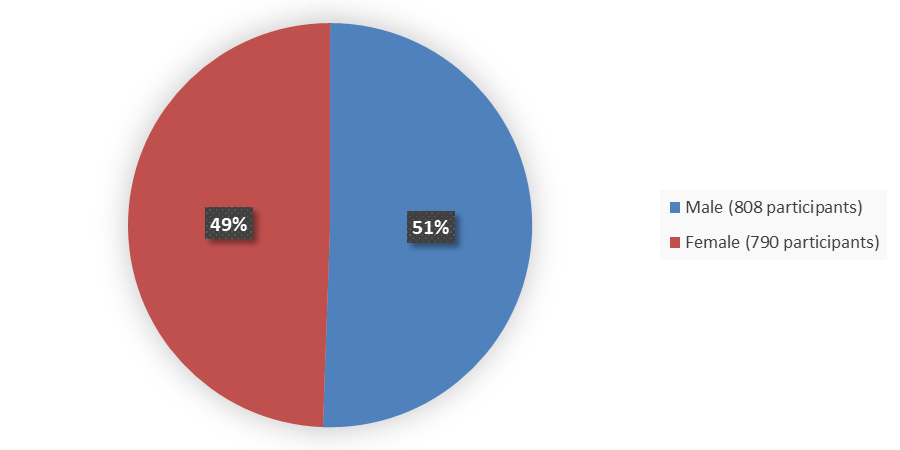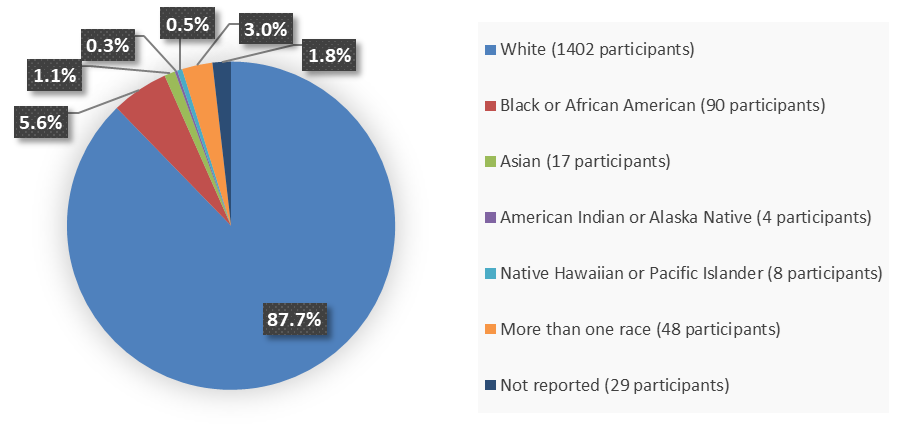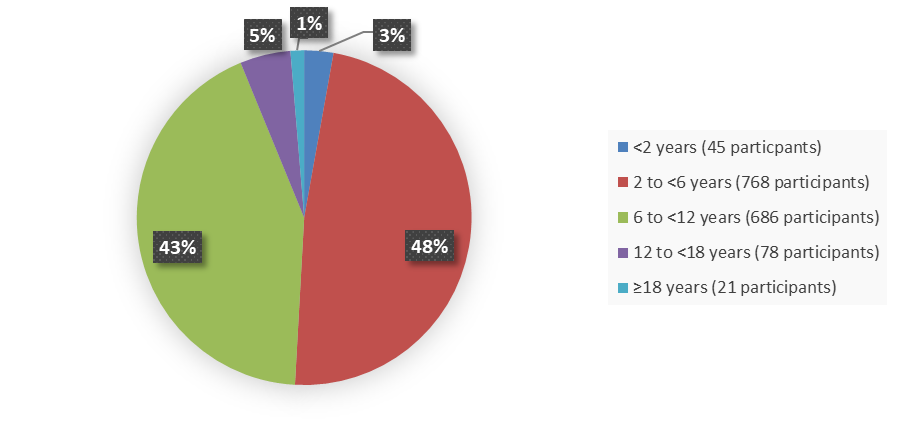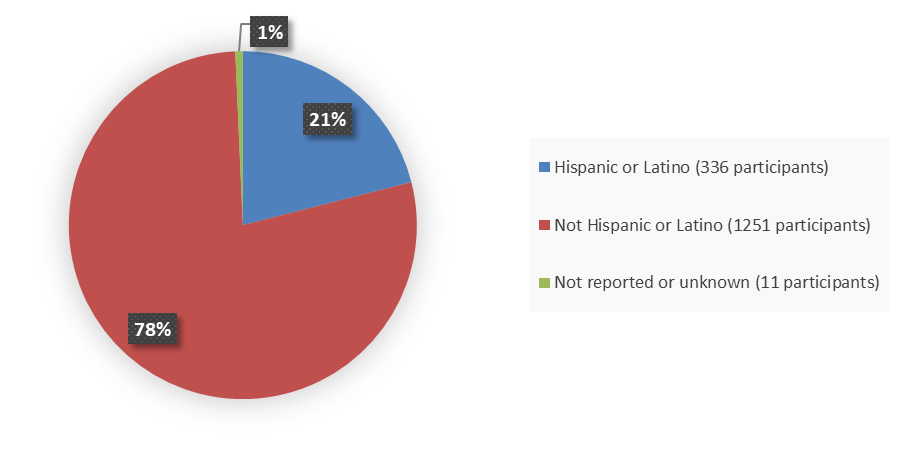Drug Trials Snapshots: ZELSUVMI
HOW TO USE THIS SNAPSHOT
The information provided in Snapshots highlights who participated in the key clinical trials that supported the original FDA approval of this drug, and whether there were differences among sex, race, age, and ethnic groups. The “MORE INFO” bar shows more detailed, technical content for each section. The Snapshot is intended as one tool for consumers to use when discussing the risks and benefits of the drugs.
LIMITATIONS OF THIS SNAPSHOT:
Do not rely on Snapshots to make decisions regarding medical care. Always speak to your healthcare provider about the benefits and risks of a drug.
Some of the information in this Snapshot is for presentation purposes and does not represent the approved conditions of use of this drug. Refer to the ZELSUVMI Prescribing Information for all of the approved conditions of use of this drug (e.g., indication(s), population(s), dosing regimen(s), safety information).
Snapshots are limited to the information available at the time of the original approval of the drug and do not provide information on who participated in clinical trials that supported later approvals for additional uses of the drug (if applicable).
ZELSUVMI (berdazimer)
zel-SOOV-mee
LNHC, Inc.
Original Approval date: January 05, 2024
DRUG TRIALS SNAPSHOT SUMMARY:
What is the drug for?
ZELSUVMI is a nitric oxide releasing agent that is indicated for the topical treatment of molluscum contagiosum (MC) in adults and pediatric patients 1 year of age and older.
How is this drug used?
ZELSUVMI is a gel applied topically to each lesion once a day.
Who participated in the clinical trials?
The FDA approved ZELSUVMI based on evidence from three clinical trials (NI-MC301, NI-MC302, and NI-MC304) of 1,598 patients with MC. The trials were conducted at 121 sites in the United States. Among the 1,598 enrolled patients, all of them were evaluated for efficacy (Intent-to-Treat population) and 1,596 were evaluated for safety.
How were the trials designed?
ZELSUVMI was evaluated in three clinical trials of 1,598 patients with MC.
In all three trials, patients with MC were randomized to receive ZELSUVMI or vehicle applied to MC lesions once daily for up to 12 weeks. Efficacy was assessed as the proportion of patients achieving complete clearance at Week 12. Complete clearance was defined as the subject having a total of MC lesion count of zero at assessment.
How were the trials designed?
The efficacy and safety of ZELSUVMI were evaluated in three clinical trials (NCT-MC301, NCT -MC302, and NCT -MC304 ) of 1,598 patients with MC. All three trials were multicenter, randomized, double-blind, vehicle-controlled trials.
Patients with MC were randomized to receive ZELSUVMI or vehicle applied to MC lesions once daily for up to 12 weeks. Efficacy was assessed as the proportion of patients achieving complete clearance at Week 12. Complete clearance was defined as the subject having a total of MC lesion count of zero at assessment.
DEMOGRAPHICS SNAPSHOT
Figure 1 summarizes how many male and female patients were enrolled in the combined clinical trials used to evaluate the efficacy of ZELSUVMI.
Figure 1. Baseline Demographics by Sex (Intent-to-Treat Population)
Source: Adapted from FDA Review
Figure 2 summarizes how many patients by race were enrolled in the combined clinical trials used to evaluate the efficacy of ZELSUVMI.
Figure 2. Baseline Demographics by Race (Intent-to-Treat Population)
Source: Adapted from FDA Review
Figure 3 summarizes how many patients by age were enrolled in the combined clinical trials used to evaluate the efficacy of ZELSUVMI.
Figure 3. Baseline Demographics by Age (Intent-to-Treat Population)
Source: Adapted from FDA Review
Figure 4 summarizes how many patients by ethnicity were enrolled in the combined clinical trials used to evaluate the efficacy of ZELSUVMI.
Figure 4. Baseline Demographics by Ethnicity (Intent-to-Treat Population)
Source: Adapted from FDA Review
Who participated in the trials?
Table 1. Baseline Demographics of Efficacy Trials by Age, Sex, Race, and Ethnicity, Intent-to-Treat Population
|
Demographic Characteristic |
NI-MC301 |
NI-MC302 |
NI-MC304 |
|||
|---|---|---|---|---|---|---|
|
ZELSUVMI |
Vehicle |
ZELSUVMI |
Vehicle |
ZELSUVMI |
Vehicle |
|
|
Age categories, years |
||||||
|
<2 |
8 (3.4) |
1 (0.9) |
5 (2.1) |
3 (2.5) |
16 (3.6) |
12 (2.7) |
|
2 to <6 |
99 (41.9) |
59 (50.9) |
116 (48.9) |
61 (51.7) |
220 (49.5) |
213 (47.7) |
|
6 to <12 |
106 (44.9) |
47 (40.5) |
108 (45.6) |
46 (39.0) |
178 (40.1) |
201 (45.0) |
|
12 to <18 |
17 (7.2) |
7 (6.0) |
8 (3.4) |
7 (5.9) |
24 (5.4) |
15 (3.4) |
|
≥18 |
6 (2.5) |
2 (1.7) |
0 |
1 (0.8) |
6 (1.4) |
6 (1.3) |
|
Sex |
||||||
|
Female |
119 (50.4) |
49 (42.2) |
110 (46.4) |
62 (52.5) |
216 (48.6) |
234 (52.3) |
|
Male |
117 (49.6) |
67 (57.8) |
127 (53.6) |
56 (47.5) |
228 (51.4) |
213 (47.7) |
|
Race |
||||||
|
White |
207 (87.7) |
100 (86.2) |
221 (93.2) |
105 (89.0) |
387 (87.2) |
382 (85.5) |
|
Black or African American |
17 (7.2) |
10 (8.6) |
9 (3.8) |
5 (4.2) |
21 (4.7) |
28 (6.3) |
|
Asian |
2 (0.8) |
2 (1.7) |
0 |
1 (0.8) |
6 (1.4) |
6 (1.3) |
|
American Indian or Alaska Native |
0 |
0 |
0 |
0 |
2 (0.5) |
2 (0.4) |
|
Native Hawaiian or Pacific Islander |
0 |
0 |
1 (0.4) |
1 (0.8) |
4 (0.9) |
2 (0.4) |
|
More than one race |
10 (4.2) |
3 (2.6) |
3 (1.3) |
6 (5.1) |
13 (2.9) |
13 (2.9) |
|
Not reported |
0 |
1 (0.9) |
3 (1.3) |
0 |
11 (2.5) |
14 (3.1) |
|
Ethnicity |
||||||
|
Not Hispanic or Latino |
167 (70.8) |
83 (71.6) |
202 (85.2) |
97 (82.2) |
345 (77.7) |
357 (79.9) |
|
Hispanic or Latino |
69 (29.2) |
33 (28.4) |
32 (13.5) |
21 (17.8) |
94 (21.2) |
87 (19.5) |
|
Not reported or unknown |
0 |
0 |
3 (1.3) |
0 |
5 (1.1) |
3 (0.7) |
Source: Adapted from FDA Review
What are the benefits of this drug?
More patients with MC achieved complete clearance after 12 weeks of treatment with ZELSUVMI in comparison to those who were treated with vehicle.
What are the benefits of this drug (results of trials used to assess efficacy)?
The primary efficacy endpoint was the proportion of patients achieving complete clearance at Week 12. Complete clearance was defined as the subject having a total MC lesion count of zero at assessment. The efficacy results are shown in Table 2.
Table 2. Efficacy Results in Studies NI-MC302 and NI-MC304, Intent-to-Treat Population
|
Endpoint |
NI-MC302 |
NI-MC304 |
||
|---|---|---|---|---|
|
ZELSUVMI |
Vehicle |
ZELSUVMI |
Vehicle |
|
|
Complete clearance rate at Week 12, n (%) |
71 (30.0) |
24 (20.3) |
144 (32.4) |
88 (19.7) |
|
Treatment difference (95% CI) |
9.2 (-0.04, 18.4) |
12.8 (7.1, 18.6) |
||
Source: Adapted from FDA Review and ZELSUVMI Prescribing Information
Abbreviations: CI, confidence interval
In NI-MC301, the complete clearance rates at Week 12 were 26% versus 22% for ZELSUVMI and vehicle, respectively, with 95% confidence interval of -5%, 14%.
Were there any differences in how well the drug worked in clinical trials among sex, race and age?
- Sex: The observed effect of ZELSUVMI was similar for females and males.
- Race: The number of patients of races other than White was small; therefore, differences in how ZELSUVMI worked among races could not be determined.
- Age: The observed effect of ZELSUVMI was larger for patients 6 to 11 years of age than patients below 6 years of age. The number of patients 2 years of age and younger or 12 years of age and older was limited; therefore, differences in how the drug worked in patients 2 years of age and younger or 12 years of age and older versus patients in other age groups could not be determined.
Were there any differences in how well the drug worked in clinical trials among sex, race, and age groups?
Subgroup analyses were conducted to assess the potential for differences in the treatment effect for various demographics in NI-MC302 and NI-MC304.
Table 3. Efficacy Results by Age, Sex, Race, and Ethnicity in Studies NI-MC302 and NI-MC304, Intent-to-Treat Population
|
Demographic |
NI-MC302 |
NI-MC304 |
|||
|---|---|---|---|---|---|
|
ZELSUVMI |
Vehicle |
ZELSUVMI |
Vehicle |
||
|
Age group, years |
|||||
|
<2 |
Complete CR at Week 12 |
2/5 (40.0) |
0/3 (0) |
2/16 (12.5) |
0/12 (0) |
|
Odds ratio (95% CI) |
NA |
NA |
|||
|
2 to <6 |
Complete CR at Week 12 |
32/116 (27.6) |
15/61 (24.6) |
63/220 (28.6) |
52/213 (24.4) |
|
Odds ratio (95% CI) |
1.215 (0.606, 2.438) |
1.288 (0.836, 1.986) |
|||
|
6 to <12 |
Complete CR at Week 12 |
36/108 (33.3) |
6/46 (13.0) |
65/178 (36.5) |
28/201 (13.9) |
|
Odds ratio (95% CI) |
3.188 (1.223, 8.310) |
3.672 (2.195, 6.143) |
|||
|
12 to <18 |
Complete CR at Week 12 |
1/8 (12.5) |
3/7 (42.9) |
12/24 (50.0) |
6/15 (40.0) |
|
Odds ratio (95% CI) |
0.173 (0.012, 2.502) |
1.399 (0.366, 5.350) |
|||
|
≥18 |
Complete CR at Week 12 |
NA |
0/1 (0) |
2/6 (33.3) |
2/6(33.3) |
|
Odds ratio (95% CI) |
NA |
NA |
|||
|
Sex |
|||||
|
Male |
Complete CR at Week 12 |
39/127 (30.7) |
13/56 (23.2) |
73/228 (32.0) |
41/213 (19.3) |
|
Odds ratio (95% CI) |
1.424 (0.714, 2.840) |
2.141 (1.369, 3.349) |
|||
|
Female |
Complete CR at Week 12 |
32/110 (29.1) |
11/62 (17.7) |
71/216 (32.9) |
47/234 (20.1) |
|
Odds ratio (95% CI) |
1.944 (0.889, 4.249) |
1.951 (1.261, 3.019) |
|||
|
Race |
|||||
|
White |
Complete CR at Week 12 |
64/221 (29.0) |
22/105 (21.0) |
120/387 (31.0) |
72/382 (18.9) |
|
Odds ratio (95% CI) |
1.517 (0.873, 2.634) |
2.031 (1.444, 2.857) |
|||
|
Black or African American |
Complete CR at Week 12 |
3/9 (33.3) |
1/5 (20.0) |
6/21 (28.6) |
6/28 (21.4) |
|
Odds ratio (95% CI) |
1.769 (0.254, 12.320) |
1.175 (0.303, 4.557) |
|||
|
Asian |
Complete CR at Week 12 |
NA |
0/1 (0) |
3/6 (50.0) |
1/6 (16.7) |
|
Odds ratio (95% CI) |
NA |
NA |
|||
|
American Indian or Alaska Native |
Complete CR at Week 12 |
NA |
NA |
1/2 (50.0) |
0/2 (0) |
|
Odds ratio (95% CI) |
NA |
NA |
|||
|
Native Hawaiian or Pacific Islander |
Complete CR at Week 12 |
0/1 (0) |
0/1 (0) |
3/4 (75.0) |
1/2 (50.0) |
|
Odds ratio (95% CI) |
NA |
NA |
|||
|
More than one race |
Complete CR at Week 12 |
2/3 (66.7) |
1/6 (16.7) |
7/13 (53.9) |
1/13 (7.7) |
|
Odds ratio (95% CI) |
NA |
14.687 (1.479, 145.860) |
|||
|
Ethnicity |
|||||
|
Not Hispanic or Latino |
Complete CR at Week 12 |
61/202 (30.2) |
19/97 (19.6) |
108/345 (31.3) |
64/357 (17.9) |
|
Odds ratio (95% CI) |
1.804 (1.002, 3.248) |
2.156 (1.503, 3.093) |
|||
|
Hispanic or Latino |
Complete CR at Week 12 |
8/32 (25.0) |
5/21 (23.8) |
35/94 (37.2) |
24/87 (27.6) |
|
Odds ratio (95% CI) |
0.951 (0.281, 3.219) |
1.671 (0.868, 3.216) |
|||
Source: Adapted from FDA Review
Abbreviations: CI, confidence interval; CR, clearance rate; N, number of patients in treatment arm; n, number of patients meeting criteria; NA, not applicable; Ns, total number of patients for each specific subgroup and were assigned to that specific arm
What are the possible side effects?
Most common side effects occurred at the drug application site including pain, rash, itch, eczema, swelling, erosion, discoloration, blister, irritation, and infection. Other common side effects included fever, vomiting, and upper respiratory infections (common cold).
What are the possible side effects (results of trials used to assess safety)?
Table 4. Adverse Reactions in ≥1% of Patients and at a Higher Rate Than Placebo in Clinical Trials of ZELSUVMI for Treatment of Molluscum Contagiosum for up to 12 Weeks, Safety Population
|
Adverse Reaction |
ZELSUVMI |
Vehicle |
|---|---|---|
|
Application site pain |
171 (18.7) |
33 (4.9) |
|
Application site erythema |
107 (11.7) |
9 (1.3) |
|
Application site pruritus |
52 (5.7) |
7 (1.0) |
|
Application site exfoliation |
46 (5.0) |
0 (0.0) |
|
Application site dermatitis |
45 (4.9) |
5 (0.7) |
|
Application site swelling |
32 (3.5) |
4 (0.6) |
|
Pyrexia |
20 (2.2) |
7 (1.0) |
|
Application site erosion |
15 (1.6) |
1 (0.1) |
|
Application site discolouration |
14 (1.5) |
1 (0.1) |
|
Application site vesicles |
14 (1.5) |
1 (0.1) |
|
Vomiting |
12 (1.3) |
1 (0.1) |
|
Application site irritation |
11 (1.2) |
0 (0.0) |
|
Upper respiratory tract infection |
11 (1.2) |
5 (0.7) |
|
Application site infection |
10 (1.1) |
3 (0.4) |
|
Nasopharyngitis |
9 (1.0) |
6 (0.9) |
|
Pharyngitis streptococcal |
9 (1.0) |
6 (0.9) |
Source: Adapted from FDA Review
Were there any differences in side effects of the clinical trials among sex, race, and age?
- Sex: The occurrence of side effects was similar between male and female patients treated with ZELSUVMI.
- Race: The occurrence of side effects was higher in white patients, compared to other races, treated with ZELSUVMI.
- Age: The occurrence of side effects was similar for patients 6 to 11 years of age and patients below 6 years of age for patients treated with ZELSUVMI. The number of patients 12 years of age and older was limited; therefore, differences in side effects in patients 12 years of age and older versus patients in other age groups could not be determined.
Were there any differences in side effects of the clinical trials among sex, race, and age groups?
Table 5. Proportion of Subjects With Treatment-Emergent Adverse Events by Subgroup Through Week 12, Safety Population
|
Subgroup |
ZELSUVMI |
Vehicle |
|---|---|---|
|
Age group, years |
||
|
<2 |
13/29 (44.8) |
4/16 (25.0) |
|
2 to <6 |
207/435 (47.6) |
93/332 (28.0) |
|
6 to <12 |
189/391 (48.3) |
64/294 (21.8) |
|
12 to <18 |
17/49 (34.7) |
5/29 (17.2) |
|
≥18 |
2/12 (16.7) |
3/9 (33.3) |
|
Sex |
||
|
Female |
217/445 (48.8) |
90/344 (26.2) |
|
Male |
211/471 (44.8) |
79/336 (23.5) |
|
Race |
||
|
White |
392/814 (48.2) |
148/586 (25.3) |
|
Black or African American |
11/47 (23.4) |
6/43 (14.0) |
|
Asian |
1/8 (12.5) |
2/9 (22.2) |
|
Native Hawaiian or Pacific Islander |
1/5 (20.0) |
1/3 (33.3) |
|
American Indian or Alaska Native |
1/2 (50.0) |
0/2 (0) |
|
More than one race |
16/26 (61.5) |
10/22 (45.5) |
|
Not Reported |
6/14 (42.9) |
2/15 (13.3) |
|
Ethnicity |
||
|
Hispanic or Latino |
89/195 (45.6) |
24/141 (17.0) |
|
Not Hispanic or Latino |
334/713 (46.8) |
145/536 (27.1) |
|
Not Reported |
4/7 (57.1) |
0/1 (0) |
|
Unknown |
1/1 (100) |
0/2 (0) |
Source: Adapted from FDA Review
GLOSSARY
CLINICAL TRIAL: Voluntary research studies conducted in people and designed to answer specific questions about the safety or effectiveness of drugs, vaccines, other therapies, or new ways of using existing treatments.
COMPARATOR: A previously available treatment or placebo that is compared to the actual drug being tested.
EFFICACY: How well the drug achieves the desired response when it is taken as described in a controlled clinical setting, such as during a clinical trial.
PLACEBO: An inactive substance or “sugar pill” that looks the same as, and is given the same way as, an active drug or treatment being tested. The effects of the active drug or treatment are compared to the effects of the placebo.
SUBGROUP: A subset of the population studied in a clinical trial. Demographic subsets include sex, race, and age groups.




